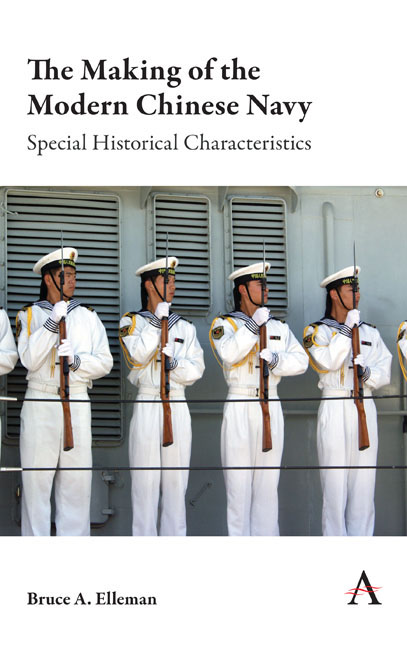Book contents
- Frontmatter
- Contents
- Introduction: The Special Characteristics of China's Maritime History
- 1 Battle of Bạch Đăng River (938)
- 2 Battle of Yaishan (1279)
- 3 Battle of Lake Poyang (1363)
- 4 Ming–Kotte War in Southeast Asia (1410–11)
- 5 Ming Loyalists Flee to Taiwan (1661–83)
- 6 Battle of Chuanbi (1839)
- 7 Sino-French War (1884–85)
- 8 Qing Beiyang Fleet's Defeat in the Battle of the Yellow Sea (1894)
- 9 Chinese Decision to Sink The Nationalist Navy as Blockships (1937)
- 10 Chongqing Mutiny Allowing the PLA to Cross the Yangzi River (1949)
- 11 The Taiwan Strait Crises (1954–55 and 1958)
- 12 China's Decision to Take the Paracel Islands from South Vietnam (1974)
- 13 Missile Blockade: The Taiwan Strait Crisis (1995–96)
- 14 The EP-3 Standoff and Diplomatic Resolution (2001)
- Conclusions: The Influence of History on the Formation of a Modern Chinese Navy
- Selected Bibliography
- Index
10 - Chongqing Mutiny Allowing the PLA to Cross the Yangzi River (1949)
Published online by Cambridge University Press: 04 October 2019
- Frontmatter
- Contents
- Introduction: The Special Characteristics of China's Maritime History
- 1 Battle of Bạch Đăng River (938)
- 2 Battle of Yaishan (1279)
- 3 Battle of Lake Poyang (1363)
- 4 Ming–Kotte War in Southeast Asia (1410–11)
- 5 Ming Loyalists Flee to Taiwan (1661–83)
- 6 Battle of Chuanbi (1839)
- 7 Sino-French War (1884–85)
- 8 Qing Beiyang Fleet's Defeat in the Battle of the Yellow Sea (1894)
- 9 Chinese Decision to Sink The Nationalist Navy as Blockships (1937)
- 10 Chongqing Mutiny Allowing the PLA to Cross the Yangzi River (1949)
- 11 The Taiwan Strait Crises (1954–55 and 1958)
- 12 China's Decision to Take the Paracel Islands from South Vietnam (1974)
- 13 Missile Blockade: The Taiwan Strait Crisis (1995–96)
- 14 The EP-3 Standoff and Diplomatic Resolution (2001)
- Conclusions: The Influence of History on the Formation of a Modern Chinese Navy
- Selected Bibliography
- Index
Summary
On February 25, 1949, the Nationalist flagship Chongqing mutinied. Prior to this event, it was widely assumed by many foreign commentators that China would be cut in half at the Yangzi River, just as Germany and Korea had been divided. Joseph Stalin hoped a divided China, with both parts of roughly equal size, would cancel each other out and leave China weak and easily influenced by the USSR. Once the rest of the Nationalist navy guarding the river also mutinied, however, this allowed the Communists to cross the Yangzi River into southern China. When the Nationalists fled to Taiwan, the Communists easily dominated all of Mainland China. After the PRC was created in 1949, within 10 years the larger-than-expected PRC was to turn from a Soviet ally to one of the USSR's greatest enemies.
Summary of the Chongqing Mutiny
The most famous twentieth-century Chinese mutiny was the case of the Nationalist flagship Chongqing, formerly the H.M.S. Aurora. The British government gave the 5,270-ton Aurora to China in May 1948. Far larger and more modern than China's other ships, Aurora was equipped with 6 six-inch guns, 6 twenty-one inch torpedo tubes, and manned by a crew of 450. Upon arrival in China, Aurora was renamed Chongqing in honor of the Nationalist's wartime capital. When Chongqing mutinied on February 25, 1949, it undermined Chiang Kai-shek's Mandate of Heaven. The rest of the Nationalist fleet soon followed. This gave the Chinese Communist forces an unforeseen and largely unhindered opportunity to cross the Yangzi River and consolidate power throughout southern China.
During 1948, Chongqing became the flagship of the Chinese navy and was assigned the task of standing guard against a possible Chinese Communist invasion across the Yangzi River into southern China. Although the Chinese government had spent an estimated ten million pounds to train the crew and deliver Chongqing to China, the poor treatment of the crew and arrears in pay led to numerous desertions. It was also reported that the popular captain of the ship was to be replaced in late February. Morale was low, even before Chongqing was assigned to the dangerous task of guarding the Yangzi River.
- Type
- Chapter
- Information
- The Making of the Modern Chinese NavySpecial Historical Characteristics, pp. 47 - 50Publisher: Anthem PressPrint publication year: 2019



